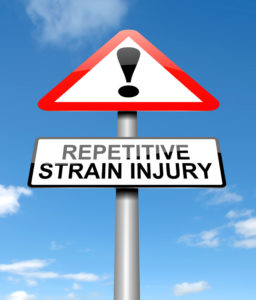To the non-medically trained eye, the terms ‘Tenosynovitis’, ‘Dupuytren’s contracture’, and ‘Epicondylitis’ might be lost on you completely. Thankfully these conditions can be grouped by a slightly more memorable name – ‘repetitive strain injury’ (RSI). Such injuries are not new, and have been in our collective consciousness for centuries. The term ‘Housemaid’s Knee’ for example has been used by generations to describe the effect of excessive kneeling, often in very manually intensive occupations. And most people have heard of ‘tennis elbow’. This occurs (not just to tennis players) when the muscles and tendons of the forearm are overworked, leading to pain in the elbow joint.
What links all of these injuries is that they are the cumulative impact of repeated body movements, which given sufficient time damage muscle, nerve, tendons – typically, but not exclusively, in the upper body.
What are the common repetitive injuries in the workplace?
Any occupation, whether manual or desk-based, requiring a specific movement of the body continuously can be stricken by RSI. Some of the most common repetitive injuries include:
- Carpel Tunnel Syndrome – Occurs progressively as the median nerve becomes compressed, causing tingling, numbness, and pins & needles in the hand and arm. This condition is commonly associated with those who use computer keyboards regularly and for long periods

- Bursitis – When the bursa (a fluid-filled sac which cushions bones, tendons, joints and muscles) becomes inflamed. The main symptom is pain at the immediate location of the inflammation. Housemaid’s Knee is an example of bursitis
- Dupuytren’s contracture – A hand deformity which occurs when the connective tissue under the palm contracts and toughens – as a result, the fingers flex in toward the palm
- Epicondylitis – Results from the overuse of muscles and tendons where the bone and tendon join
- Ganglion – These are fluid-filled sacs which occur on top of joints or tendons in the wrists, hands and feet
- Rotator-Cuff Syndrome – Inflammation of the muscles and tendons within the shoulder joint
- Tendonitis – A common injury caused by the inflammation of tendons
Other RSI injuries include Tenosynovitis, Trigger Finger, Nerve Entrapment Disorder and Ulnar Tunnel Sydrome.
What actions cause RSI?
As we have established, it is the continuous and repeated movement of a part of the body that causes the gradual damage, if not detected and prevented. RSI can be caused by a wide range of forces including twisting, hammering, pushing, pulling, pounding, lifting, squeezing, and reaching. These are compounded by factors such as excessive workloads, lack of variety of work task, lack of correct protective/safety equipment, insufficient breaks, insufficient workplace risk assessments, poor management of early symptoms of overuse injuries, poor working environments and poorly maintained equipment.
Which occupations are most at risk?
A wide-range of occupations can be affected by RSI, however, some that are impacted more than most:
- Office workers – or any occupation that requires many hours at a computer keyboard
- Drivers – due to many hours spent in the same position, repeating the same actions
- Cooks – who often spend hours preparing food, using repeated motions (e.g. whisking, chopping)
- Machine operators – repeating the same physical action repeatedly
- Road maintenance personnel – often due to the vibration of power tools
What is the impact of RSI?
RSI can cause a huge range of physical symptoms – numbness, loss of sensation, tingling, pain, swelling, loss of range of motion in the joints, and loss of strength. Symptoms are rated from mild, moderate, to severe, and left to continue without corrective action and treatment can lead to permanent disablement. As a result of serious RSI, it might not be possible for an employee to return to their original role, at the risk of making the injury worse. If the condition becomes chronic, the injury may require years to recover, or may even be irreversible.
Preventing RSI before it develops
There are a many modifications that can be made to the workplace environment, equipment, methods used, and length of time exposed to risks, to significantly reduce the chance of an overuse injury. Under the Management of Health and Safety at Work Regulations 1999, the employer must perform detailed risk assessments to ensure the health and safety of workers. This includes the careful analysis of each task that a worker is being asked to perform, to look for any situations that could lead to injury. Once undertaken, an action plan must be documented and put in place to ensure that risks are prioritised, prevented, reduced and monitored.
Claiming for a repetitive injury in the workplace
Claiming compensation for an injury in the workplace may be possible if it can be established that your employer failed to protect you from the injury you have suffered. By contacting one of our expert workplace injury solicitors, we will take the time to listen to your circumstances, and give you an honest assessment of your chances of receiving a settlement. Most of our personal injury work on a ‘no-win-no-fee’ basis, which gives you the confidence of knowing that you will not pay us if the case is unsuccessful.
At Russell Worth Solicitors we specialise in personal injury claims. If you have been diagnosed with an overuse injury as a result of your occupation, please call us now on 0800 028 2060 or complete our Online Claim Assessment.

